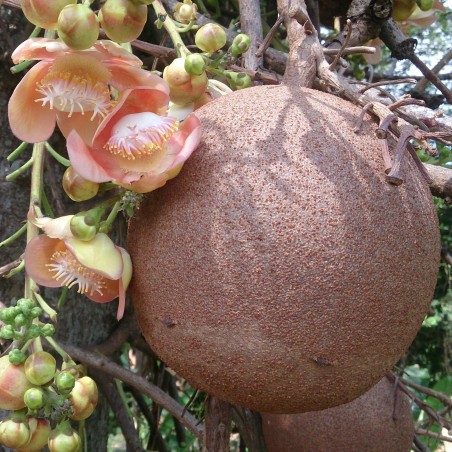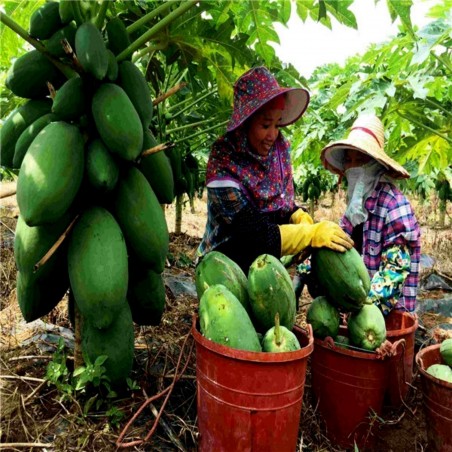
Cannonballträd Fröer (den Couroupita Guianensisen)
Cannonballträd Fröer (den Couroupita Guianensisen)
Pris för Paket med 3 frön.
Cannonballträd - Kanonkula träd (Couroupita guianensis) växer inbyggt i hela södra Centralamerika och norra Sydamerika. Hinduiska tempel använder träd som en helig växt, enligt University of British Columbia
Cannonballträd Fröer (den Couroupita Guianensisen)
Pris för Paket med 3 frön.
Cannonballträd - Kanonkula träd (Couroupita guianensis) växer inbyggt i hela södra Centralamerika och norra Sydamerika. Hinduiska tempel använder träd som en helig växt, enligt University of British Columbia Botanical Gardens hemsida. Det gemensamma namnet för växten kommer från det faktum att frukten, som växer i klasar på stammen och huvudgrenar, ser ut som bruna kanonkulor. Blommorna i kanonkula träd växa till stora storlekar och producera en söt doft.
Couroupita guianensis, known by a variety of common names including cannonball tree,[2] is a deciduous tree in the family Lecythidaceae, which also includes the Brazil nut (Bertholletia excelsa) and Paradise nut Lecythis zabucajo. It is native to the rainforests of Central and South America,[3] and it is cultivated in many other tropical areas throughout the world because of its beautiful, fragrant flowers and large, interesting fruits.[4] There are medicinal uses for many parts of Couroupita guianensis,[5] and the tree has cultural and religious significance in India,[5] Sri Lanka, and Southeast Asia.
Couroupita guianensis is a tree that reaches heights of up to 35 metres (110 ft). The leaves, which occur in clusters at the ends of branches, are usually 8 to 31 centimeters (3 to 12 inches) long, but can reach lengths of up to 57 centimeters (22 inches).[7] The flowers are born in racemes up to 80 centimeters (31 inches) long. Some trees flower profusely until the entire trunk is covered with racemes. One tree can hold as many as 1000 flowers per day. The flowers are strongly scented, and are especially fragrant at night[8] and in the early morning.[7] They are up to 6 centimeters (2.5 inches) in diameter, with six petals, and are typically brightly colored, with the petals ranging from shades of pink and red near the bases to yellowish toward the tips. There are two areas of stamens: a ring of stamens at the center, and an arrangement of stamens that have been modified into a hood.[7] The fruits are spherical with a woody shell and reach diameters of up to 25 centimeters (10 inches), which give the species the common name "cannonball tree". Smaller fruits may contain about 65 seeds, while large ones can hold as many as 550.[7] One tree can bear 150 fruits. The fruits take up to a year to mature in most areas, sometimes as long as 18 months.
Scientific and common names
The tree was named Couroupita guianensis by the French botanist Jean Baptiste Christophore Fusée Aublet in 1755. Common names in other languages include many translations of the English cannonball tree. Common names include macacarecuia (Portuguese), coco sachapura (Colombia, Panama), bala de cañón (Costa Rica, Panama), kanonskogelboom (Dutch), arbre à boulet de canon (French), kouroupitoumou (French Guiana), nagkeshar (Bengali), Nagalinga Pushpa (Kannada), Nagalingam or Lingam (Tamil), నాగమల్లి Nagamalli (Telugu), sala (Indonesia), granadillo de las huacas (Panama), ayahuma (Peru), and boskalebas (Suriname).[9] It is also called Naaga danthee in Malayalam and Nagakeshara ନାଗକେଶର in Odia.
Pollination
Although the flowers lack nectar, they are very attractive to bees, which come for the pollen. The flowers produce two types of pollen: fertile pollen from the ring stamens, and sterile pollen from the hood structure. The pollinators must work their way between the two areas of stamens as they gather the pollen. The carpenter bee Xylocopa brasilianorum is a common pollinator of cultivated trees in Rio de Janeiro, just outside the tree's native range. Other carpenter bees such as Xylocopa frontalis, as well as wasps, flower flies, and bumblebees, are also known visit the flowers.
Dispersal
The seeds are dispersed by animals that feed on the fruits. When the fruits fall to the ground, the hard, woody shell usually cracks open, exposing the pulp and seeds. Fruits that remain whole may be broken open by animals such as pecarries. Many animals feed on the pulp and seeds, including peccaries, the paca, and domestic chickens and pigs. The seeds are covered with trichomes which may protect them as they pass through the animals' digestive systems.
Human uses
Couroupita guianensis is planted as an ornamental for its showy, scented flowers, and as a botanical specimen for its interesting fruit.
The fruit is edible, but is not usually eaten by people because it can have an unpleasant smell.[9] It is fed to livestock such as pigs and domestic fowl.
There are many medicinal uses for the plant. Native Amazonians use extracts of several parts of the tree to treat hypertension, tumors, pain, and inflammation. It has been used to treat the common cold, stomachache, skin conditions and wounds, malaria, and toothache.[5] The fruit pulp is rubbed on sick dogs to cure them of mange.[10] Laboratory tests show that extracts of the plant have some antimicrobial activity and inhibit the formation of biofilms
Cultural significance
In India, the tree is sacred to Hindus, who believe its hooded flowers look like the nāga, and it is grown at Shiva temples.
According to Buddhist tradition, Maya held onto the branch of a blossoming sal tree (Shorea robusta) while she was giving birth to the Lord Buddha. Because of this, the sal tree is revered by many Buddhist people around the world. For reasons that remain unclear, after C. guianensis was introduced from Guyana to a botanical garden in Sri Lanka in 1881, the tree was mistakenly believed to be Shorea robusta and has been planted around many Buddhist temples in Sri Lanka and Southeast Asia.
| HEIRLOOM ? | Ja |
|---|---|
| Ekologiskt utsäde ? | Ekologiska frön |
| Ätlig? | Ätbar |
| Perenn ? | Stauder: Ja |
| Handplockade frö? | Handpickade frön |
| Lämplig för Blomkruka? | Lämplig för Blomkruka: Ja |


Din uppskattning av recensionen kan inte skickas
Anmäl kommentar
Rapporten har skickats
Din rapport kunde inte skickas
Skriv din recension
Recension skickad
Din recension kunde inte skickas
🌍 Global Leverans från Europeiska Unionen
Vi skickar globalt från Europeiska unionen med rekommenderad post inklusive leveransbekräftelse.
📦 Spåra din försändelse
Logga in på ditt konto och gå till Orderhistorik > Detaljer för att hitta ditt spårningsnummer.
Global spårning: 17Track
För nummer som RGxxxxxxHR: Posta.hr-spårning
🕒 Vänta minst 24 timmar efter att produkten har skickats innan spårningsinformationen blir tillgänglig.
⚠️ Viktig information
Postförskott accepteras inte.
Kontrollera regelbundet din skräppost-/spam-mapp för viktiga e-postmeddelanden.
Använd endast vårt kontaktformulär på webbplatsen.
E-postmeddelanden som skickas direkt till vår e-postadress kan gå förlorade.
📱 Viktigt med telefonnummer
Ange ditt mobilnummer inklusive landskod.
Exempel: +46 701 234 567
🚚 Leveransvillkor
Rekommenderade försändelser kräver underskrift av mottagaren.
Beställ inte om:
Du vill ha leverans till en brevlåda
Du inte är hemma för att ta emot paketet
Du vill att paketet ska lämnas hos en granne (inte möjligt)
📬 Om du anger en brevlådeadress och paketet går förlorat får du inte någon återbetalning.
↩️ Returer och återleverans
Om paketet returneras till oss:
En returavgift på 2 € tillkommer
Plus kostnaden för att skicka om paketet
⏱ Förseningar och spårning
Om spårningen visar att paketet fortfarande är hos avsändaren, betyder det att det är på väg.
Kontakta din lokala posttjänst med spårningsnumret.
Vi är inte posten och kan inte spåra paketet åt dig.
Vi ansvarar inte för leveranstiden.
🔍 Vi kan starta en förlustutredning först 30 dagar efter att paketet skickats.
✈️ Leveransalternativ
| Leveransmetod | Behandlingstid | Försäkring | Eventuell försening | Kommentar |
|---|---|---|---|---|
| Standard | 7–10 arbetsdagar | ❌ | 7–14 arbetsdagar | Ekonomiskt val |
| Prioriterad | 1–7 arbetsdagar | ❌ | 3–10 arbetsdagar | Prioriterad hantering – inte nödvändigtvis snabbare leverans |
| Försäkrad | 1–7 arbetsdagar | ✅ | 3–10 arbetsdagar | Återbetalning vid förlust, gäller för beställningar upp till 150 € |
🕒 Uppskattad leveranstid:
Inom EU: 3–20 arbetsdagar
Internationellt: 5–30 arbetsdagar
Exempel på leveranstider till USA: 27, 22, 19, 17, 13 dagar
💳 Betalningsmetoder
💶 Banköverföring (SEPA / IBAN / SWIFT-BIC)
Ange ordernummer i meddelandet (t.ex. SGS-19811702).
Saknas referens kan det leda till försening eller avbokning.
Beställningar utan betalning inom 7 dagar avbryts automatiskt.
🅿️ PayPal
Endast betalningar i euro (EUR) accepteras.
Byt valuta till euro under betalningen.
💳 Kortbetalning
Betalning sker via vår butik: Exotic Seeds Store
Vi accepterar: Visa, MasterCard, American Express, Diners Club, UnionPay, JCB, Discover m.fl.
💡 Köparen står för eventuella transaktionskostnader.
Skicka gärna betalningsbevis så vi kan behandla din beställning snabbare.
📅 Viktigt att veta
Vi behandlar inte beställningar på helger (lördag eller söndag).
Läs alltid igenom eventuella viktiga meddelanden på webbplatsen (helgdagar, specialvillkor etc.).
📫 OBS:
Skicka inte e-post direkt till vår e-postadress. Använd endast kontaktformuläret på vår hemsida för support.
Related Products























